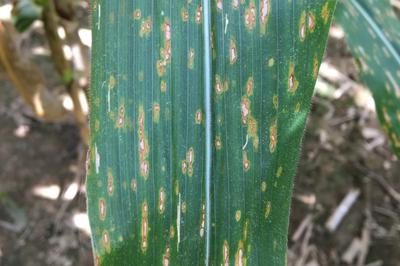Grey Leaf Spot of Maize
Cercospora zeae-maydis
Fungus
In a Nutshell
- small, pinpoint lesions surrounded by yellow halos.
- Lesions coalesce and blighting of the whole leaf may result.
Can also be found in
Symptoms
Small necrotic (brown or tan) spots that may have a yellow chlorotic halo appear on lower leaves, usually before flowering. Gradually these lesions will turn grayish and appear on younger leaves, too. As the disease progresses, they enlarge into elongated, rectangular lesions that run parallel to the leaf veins. In optimal conditions (warm temperatures, high humidity and wet leaves), they can coalesce and engulf the whole leaf. If this happens before grain filling there can be considerable yield losses. The leaf blight can weaken the plants and sometimes soften the stalks, leading to lodging.
Recommendations

Organic Control
No biological control is available to control this disease.

Chemical Control
Always consider an integrated approach with preventive measures and biological treatments if available. Foliar fungicide treatment is a way to manage the disease if it occurs at early stages but it has to be weighted against the weather conditions, the potential yield loss and the susceptibility of the plant. Fungicides containing pyraclostrobin and strobilurin, or combinations of azoxystrobin and propiconazole, prothioconazole and trifloxystrobin work well to control the fungus.
What caused it?
The gray leaf spot disease is caused by the fungus Cercospora zeae-maydis. It survives in plant residues in the soil for long periods of time. During the spring, the spores are carried onto the lower leaves by rain splashes and wind. Its lifecycle is favored by elevated temperatures (25 to 30°C), high humidity (dews, fogs) and leaf wetness for prolonged periods of time. Hot, dry weather hinders its development. Symptoms vary slightly between different plant varieties. The fungus completes its lifecycle (from infection to production of new spores) in 14-21 days in a susceptible variety and in 21-28 days in a resistant one.
Preventive Measures
- Plant resistant varieties if available in your area.
- Plant late to avoid adverse conditions for plants.
- Keep up good ventilation by widening the space between plants.
- Plow deep and bury all plant residues after harvest.
- Plan long-term crop rotations with non-host plants.



